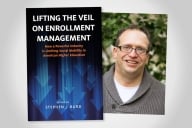You have /5 articles left.
Sign up for a free account or log in.
WASHINGTON -- As policy makers here ponder new ways to hold colleges more accountable for how well they serve students, they should start by laying down some tougher minimum standards that institutions must meet to receive federal benefits, according to a new report published Wednesday by the Education Trust.
The policy paper -- titled “Tough Love: Bottom-Line Quality Standards for Colleges” -- calls for the federal government to demand better performance from a wide range of colleges and universities in exchange for the $180 billion it pours each year into student loans, grants and higher education tax breaks.
The authors, Michael Dannenberg and Mary Nguyen Barry of the Education Trust, a nonprofit that advocates for educational equity, propose an accountability system that sets requirements for how well colleges must enroll low-income students, graduate students, and produce graduates who can pay back their loans.
“No longer should federal higher education money flow unabated and unquestioned to institutions that neglect their public duty to educate successfully the students they admit and to enroll low-income students at least at a bare-minimum level,” they argue in the report.
Specifically, under the proposal, four-year colleges would face penalties if they were among the lowest-performing 5 percent of institutions in each of three categories: percentage of Pell Grant-eligible students; graduation rates; and loan repayment rates. The authors dub such low-performing institutions in each category, respectively, as “engines of inequality,” “college dropout factories,” and “diploma mills.”
The proposal’s metrics are similar to those that the Obama administration has floated as possible standards for the college ratings system it is currently developing. But instead of universal ratings, the Education Trust paper calls for a focus on the worst-performing institutions in each category.
“We support the president’s college ratings proposal in concept,” Dannenberg said in an interview. But, he said, it’s a challenge figuring out how to do that accurately.
“We need virtually all colleges and universities to improve,” he added. “It’s much easier to measure universities at the extreme of quality. Others have spent a lot of time figuring out how to identify the best of the best. We’re challenging the worst colleges to improve their performance.”
Scrutiny of For-Profit Colleges, ‘Tough Love’ For the Elite
In raising concerns about the worst performing institutions when it comes to completion rates and loan repayment behavior, the report echoes many other calls for greater institutional accountability in recent years. For instance, Senate Democrats and the Obama administration have scrutinized for-profit colleges on such measures.
And indeed the report’s list of the worst colleges for student loan defaults (those having a three-year cohort default rate higher than 28 percent) are largely for-profit institutions. For-profit colleges similarly represent a large share of the lowest-performing colleges in the graduation rate category (those failing to graduate at least 15 percent of all first-time, full-time freshmen).
But the report also tackles a far-less discussed metric for holding colleges accountable: access for low-income students.
The paper calls out colleges that fall into the bottom 5 percent of institutions enrolling Pell-Grant-eligible students (that is, those with a student body with fewer than 17 percent of such students). Nonprofit institutions, particularly elite research universities -- such as Stanford, Yale and Princeton -- are at the top of that list.
“We think that many of these institutions are serving all kinds of public purposes and serving them well -- research for example -- but they need to do a better job on low-income student access,” Dannenberg said. “Colleges are supposed to serve as engines of economic mobility, they’re supposed to correct inequalities, not calcify them.”
He added that he thinks federal pressure in this area can be particularly effective, citing the questioning several years ago by Senator Charles Grassley of Iowa about how elite colleges were spending their large endowments. The scrutiny, he said, was partially responsible for the wave of wealthy institutions to offer far more generous loan-free financial aid packages.
Still, under the proposal, such elite colleges -- and any other institutions failing the access metric -- would face less severe sanctions than those colleges that perform poorly on the graduation and loan repayment (or default) rate metrics.
All institutions that fail the metrics would have several years to improve. After that point, the federal government would start to take away institutional grant and tax benefits (including the charitable interest deduction) from low-access institutions.
Low-graduation and low-loan repayment institutions would be subject to the same penalties in addition to a loss of federal student aid eligibility.








